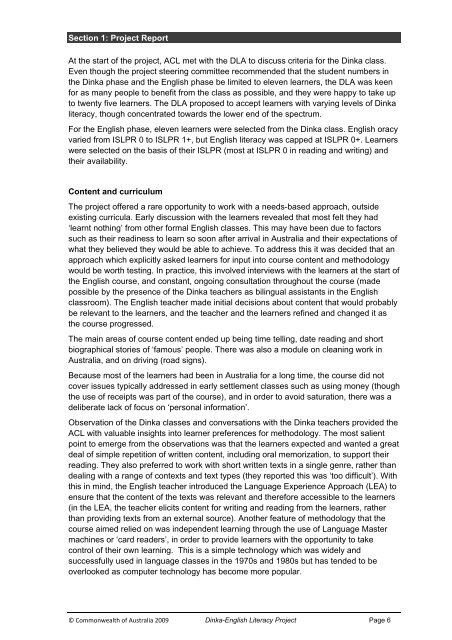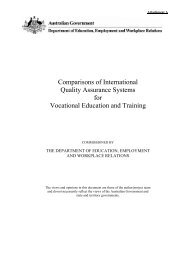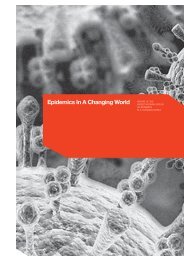First Language (Dinka) Literacy as a Foundation for English ...
First Language (Dinka) Literacy as a Foundation for English ...
First Language (Dinka) Literacy as a Foundation for English ...
You also want an ePaper? Increase the reach of your titles
YUMPU automatically turns print PDFs into web optimized ePapers that Google loves.
Section 1: Project Report<br />
At the start of the project, ACL met with the DLA to discuss criteria <strong>for</strong> the <strong>Dinka</strong> cl<strong>as</strong>s.<br />
Even though the project steering committee recommended that the student numbers in<br />
the <strong>Dinka</strong> ph<strong>as</strong>e and the <strong>English</strong> ph<strong>as</strong>e be limited to eleven learners, the DLA w<strong>as</strong> keen<br />
<strong>for</strong> <strong>as</strong> many people to benefit from the cl<strong>as</strong>s <strong>as</strong> possible, and they were happy to take up<br />
to twenty five learners. The DLA proposed to accept learners with varying levels of <strong>Dinka</strong><br />
literacy, though concentrated towards the lower end of the spectrum.<br />
For the <strong>English</strong> ph<strong>as</strong>e, eleven learners were selected from the <strong>Dinka</strong> cl<strong>as</strong>s. <strong>English</strong> oracy<br />
varied from ISLPR 0 to ISLPR 1+, but <strong>English</strong> literacy w<strong>as</strong> capped at ISLPR 0+. Learners<br />
were selected on the b<strong>as</strong>is of their ISLPR (most at ISLPR 0 in reading and writing) and<br />
their availability.<br />
Content and curriculum<br />
The project offered a rare opportunity to work with a needs-b<strong>as</strong>ed approach, outside<br />
existing curricula. Early discussion with the learners revealed that most felt they had<br />
‘learnt nothing’ from other <strong>for</strong>mal <strong>English</strong> cl<strong>as</strong>ses. This may have been due to factors<br />
such <strong>as</strong> their readiness to learn so soon after arrival in Australia and their expectations of<br />
what they believed they would be able to achieve. To address this it w<strong>as</strong> decided that an<br />
approach which explicitly <strong>as</strong>ked learners <strong>for</strong> input into course content and methodology<br />
would be worth testing. In practice, this involved interviews with the learners at the start of<br />
the <strong>English</strong> course, and constant, ongoing consultation throughout the course (made<br />
possible by the presence of the <strong>Dinka</strong> teachers <strong>as</strong> bilingual <strong>as</strong>sistants in the <strong>English</strong><br />
cl<strong>as</strong>sroom). The <strong>English</strong> teacher made initial decisions about content that would probably<br />
be relevant to the learners, and the teacher and the learners refined and changed it <strong>as</strong><br />
the course progressed.<br />
The main are<strong>as</strong> of course content ended up being time telling, date reading and short<br />
biographical stories of ‘famous’ people. There w<strong>as</strong> also a module on cleaning work in<br />
Australia, and on driving (road signs).<br />
Because most of the learners had been in Australia <strong>for</strong> a long time, the course did not<br />
cover issues typically addressed in early settlement cl<strong>as</strong>ses such <strong>as</strong> using money (though<br />
the use of receipts w<strong>as</strong> part of the course), and in order to avoid saturation, there w<strong>as</strong> a<br />
deliberate lack of focus on ‘personal in<strong>for</strong>mation’.<br />
Observation of the <strong>Dinka</strong> cl<strong>as</strong>ses and conversations with the <strong>Dinka</strong> teachers provided the<br />
ACL with valuable insights into learner preferences <strong>for</strong> methodology. The most salient<br />
point to emerge from the observations w<strong>as</strong> that the learners expected and wanted a great<br />
deal of simple repetition of written content, including oral memorization, to support their<br />
reading. They also preferred to work with short written texts in a single genre, rather than<br />
dealing with a range of contexts and text types (they reported this w<strong>as</strong> ‘too difficult’). With<br />
this in mind, the <strong>English</strong> teacher introduced the <strong>Language</strong> Experience Approach (LEA) to<br />
ensure that the content of the texts w<strong>as</strong> relevant and there<strong>for</strong>e accessible to the learners<br />
(in the LEA, the teacher elicits content <strong>for</strong> writing and reading from the learners, rather<br />
than providing texts from an external source). Another feature of methodology that the<br />
course aimed relied on w<strong>as</strong> independent learning through the use of <strong>Language</strong> M<strong>as</strong>ter<br />
machines or ‘card readers’, in order to provide learners with the opportunity to take<br />
control of their own learning. This is a simple technology which w<strong>as</strong> widely and<br />
successfully used in language cl<strong>as</strong>ses in the 1970s and 1980s but h<strong>as</strong> tended to be<br />
overlooked <strong>as</strong> computer technology h<strong>as</strong> become more popular.<br />
© Commonwealth of Australia 2009 <strong>Dinka</strong>-<strong>English</strong> <strong>Literacy</strong> Project Page 6
















